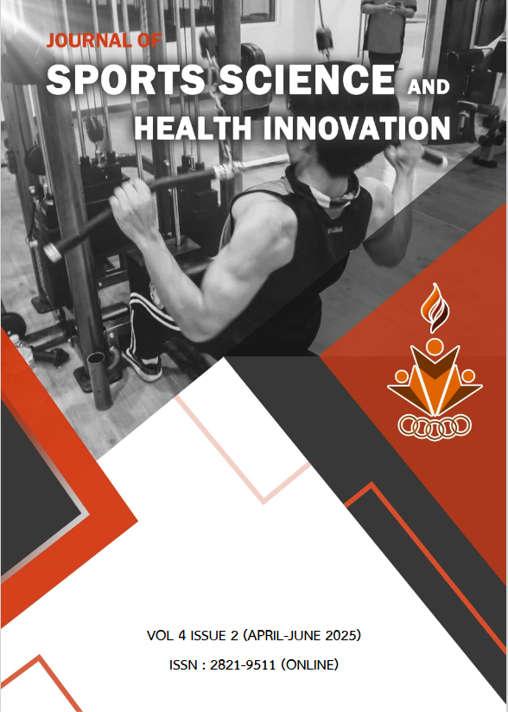EFFECTS OF STATION-BASED TRAINING PROGRAM ON THE AGILITY OF MALE SOCCER PLAYERS IN THE SPORTS CLASSROOM PROJECT AT SARAKHAM PITTAYAKOM SCHOOL, MAHA SARAKHAM PROVINCE
Main Article Content
Abstract
This study aimed to examine the effects of a station-based training program on the agility of male soccer players participating in the Sports Classroom Project at Sarakham Pittayakhom School, Maha Sarakham Province, and to compare their agility before training and after an 8-week training period. The sample comprised 15 purposively selected 15-year-old soccer players who exhibited below-standard agility. Participants engaged in a station-based training program for 8 weeks, attending three sessions per week (Tuesday, Wednesday, and Thursday) from 16:30 to 17:00. The instruments employed in this research were the station-based training program and the Semo Agility Test. Data were analyzed using the mean, standard deviation, and paired sample t-test. The results indicated that the mean best time recorded by the Semo Agility Test differed significantly (p < 0.05) between the pre-training and post-8-week training measurements. Moreover, after the 8-week training period, the station-based training program produced a statistically significant improvement (p < 0.05) in the agility of the male soccer players compared to their pre-training performance.
Article Details
เนื้อหาและข้อมูลในบทความที่ลงตีพิมพ์ในวารสารวิทยาศาสตร์การกีฬาและนวัตกรรมสุขภาพ กลุ่มมหาวิทยาลัยราชภัฏแห่งประเทศไทย ถือเป็นข้อคิดเห็นและความรับผิดชอบของผู้เขียนบทความโดยตรงซึ่งกองบรรณาธิการวารสาร ไม่จำเป็นต้องเห็นด้วย หรือร่วมรับผิดชอบใด ๆ
บทความ ข้อมูล เนื้อหา รูปภาพ ฯลฯ ที่ได้รับการตีพิมพ์ในวารสารวิทยาศาสตร์การกีฬาและนวัตกรรมสุขภาพ กลุ่มมหาวิทยาลัยราชภัฏแห่งประเทศไทย ถือเป็นลิขสิทธิ์ของคณะวิทยาศาสตร์และเทคโนโลยี มหาวิทยาลัยราชภัฏศรีสะเกษ หากบุคคลหรือหน่วยงานใดต้องการนำทั้งหมดหรือส่วนหนึ่งส่วนใดไปเผยแพร่ต่อหรือเพื่อกระทำการใด จะต้องได้รับอนุญาตเป็นลายลักษณ์อักษรจากวารสารวิทยาศาสตร์การกีฬาและนวัตกรรมสุขภาพ กลุ่มมหาวิทยาลัยราชภัฏแห่งประเทศไทย ก่อนเท่านั้น
References
Bettle, J. (2010). Balsom agility drill [Online]. Retrieved June 30, 2023, https://www.youtube.com/watch?v=WZKPcC-7mhU
Chantasorn, N. (2019). Agility development by plyometric training. Veridian E-Journal, Silpakorn University Humanities Social Sciences and arts, 12(5), 578-598. (In Thai)
Hattha, H. (2014). Effect of plyometric training on agility of futsal players. Master of science (Sports Science), Major Field: Sports Science, Faculty of Sports Science. Bangkok: Kasetsart University. (In Thai)
Kunaphisit, W. (2002). Sports science. Bangkok: Thai Wattana Panich. (In Thai)
Phetploynin, P. (2017). The effect of complex training upon agility and speed of male footballplayer. Master of Education Degree in Learning Management Health and Physical Education. Bangkok: Srinakharinwirot University. (In Thai)
Ratchatranon, W. (2014). Social science research techniques. Bangkok: Kasetsart University. (In Thai)
Satianpoonsook, T., et al. (2021). The effects of a blended training program on agility of football players at Nakhonratchasima College. The Journal of Faculty of Nursing Burapha University, 29(4), 90-98. (In Thai)
Sports Authority of Thailand. (2005). Physical fitness of football athletes. Bangkok: Sports Science Division, Sports Science Division Sports Authority of Thailand. (In Thai)
Supanyabutra, C., & Thammasaovapaak, S. (2012). The effect of sap model training on football dribbling ability. The Journal of Khonkaen University, 12(4), 102-110. (In Thai)


